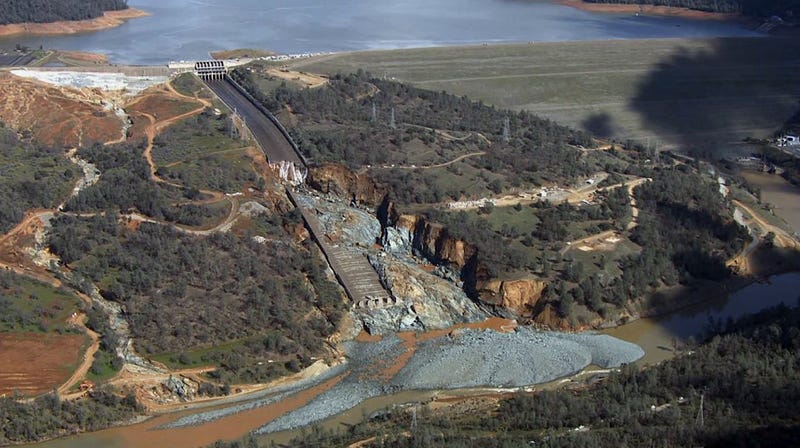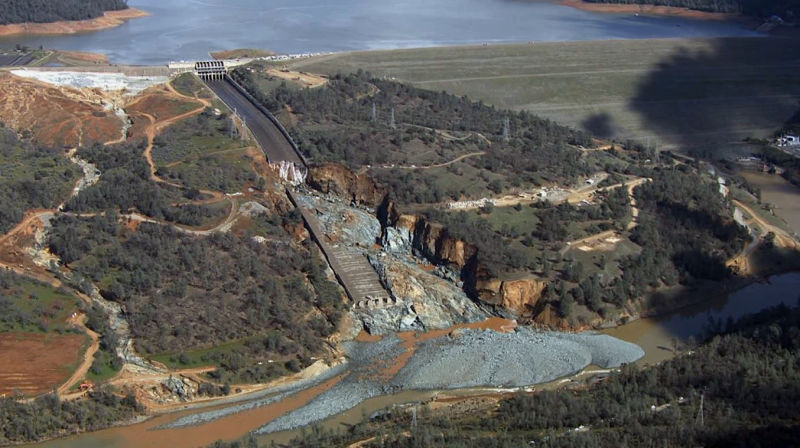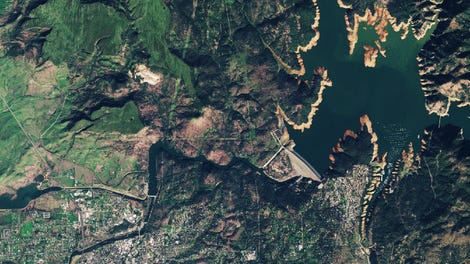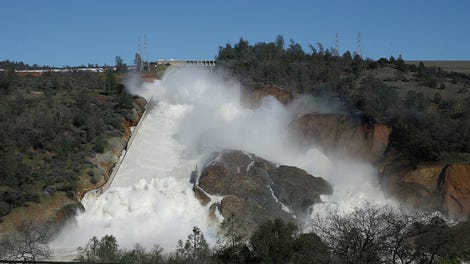
For three weeks in February, torrents of water rushed down the emergency spillway at Oroville dam, prompting fears that the entire structure would collapse. New images show what’s left of the 3,000-foot long concrete spillway—and the tremendous challenge that now confronts repair crews.
Advertisement
Aerial photos of the Oroville dam show the bottom portion of the spillway completely ripped to shreds, and a dramatic canyon wall with steep cliffs running along side of it. Bits of concrete, rock, mud, and timber lie at the bottom of the structure, clogging the Feather River.
Some 188,000 people from Oroville had to be evacuated in mid-February after the spillway showed signs of failure. Weeks of heavy rain prompted officials to release overflowing water from the massive reservoir, but once the flow proved more than the chute could handle, concern emerged that the dam itself might collapse. Mercifully, the structure held.
Earlier this week, California’s Department of Water Resources turned off the flow of water, allowing for preliminary inspections of the damaged spillway, and to allow workers to start on what appears to be a monumental cleanup. Once the debris is removed from the lower channels, the DWR can restart flow through the dam itself and switch the hydroelectric plant back on. The hydro plant has been out of action for weeks, removing 819 megawatts of power from the local grid.
As the new photos show, the damage is quite serious, and concerns remain about the integrity of facility given that there are still five more weeks to go in California’s rainy season—not to mention the billions of gallons of water that will rush to the reservoir once the snowpack in the Sierra Nevada starts to melt.
The image above shows just how difficult the repairs are going to be. The erosion caused by the rushing waters created a sizeable hole in the midsection of the spillway. Writing in the American Geophysical Union’s Landslide Blog, geologist Dave Petley says the new structure “will need to be properly founded onto competent rock” as it appears that “sections of the spillway that initially appear to be undamaged are in fact weakened.”
As reported in the Sacramento Bee, officials are giving some thought to creating a new spillway in preparation for the 2017-18 rainy season. In the meantime, experts aren’t worried about the condition of the damaged spillway, saying it can still handle overflow waters should the need arise. It appears that the bedrock below the undamaged part of the spillway is much stronger than the weathered material on the upper portion of the hillside. And when filled with water, the hole created by the erosion should act as a kind of shock absorber. As one expert told the Sacramento Bee, “It has the ability to absorb and dissipate energy.”
The spillway was supposed to be able to handle 250,000 cubic feet of water per second (cfs), but its midsection collapsed on February 7th when a relatively tame 55,000 cfs poured down it. Theories as to what went wrong are starting to emerge. As the Sacramento Bee reports:
Advertisement
Advertisement
[Engineering consultant Paul Tullis points] to a phenomenon known as “cavitation,” in which the blast of tiny water bubbles gushing down the chute at 50 mph effectively jack-hammered holes in weakened sections of concrete. Others, such as Robb Moss, a professor of geotechnical engineering at Cal Poly San Luis Obispo, speculate that roots from trees growing along the chute expanded weaknesses in the concrete.
[David] Rogers, the dam failure expert from Missouri, said the spillway may have had cracks that weren’t properly patched. He also theorized the failure may have been tied to California’s five-year drought: The aging spillway could have weakened as it underwent contractions due to the sudden heavy soaking following years of dry weather.
The Federal Energy Regulatory Commission, which licenses the dam, has ordered the state to open an investigation.
[Sacramento Bee via Landslide Blog]
















